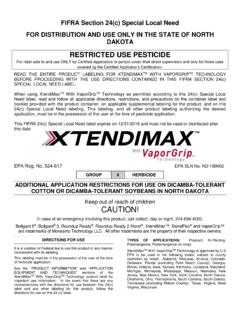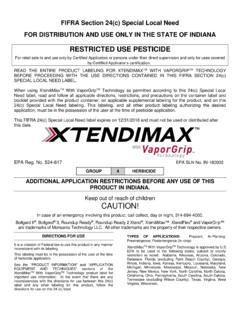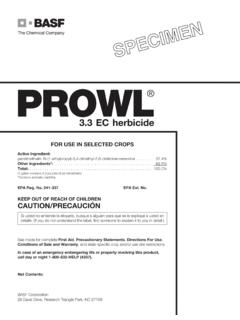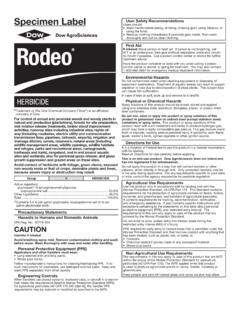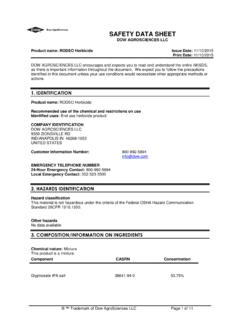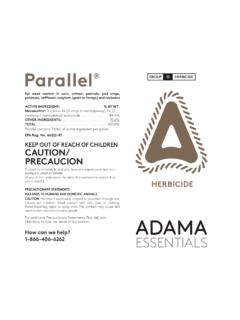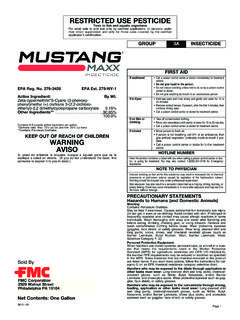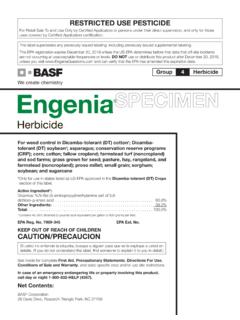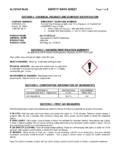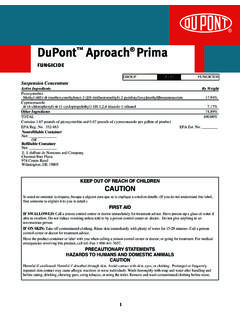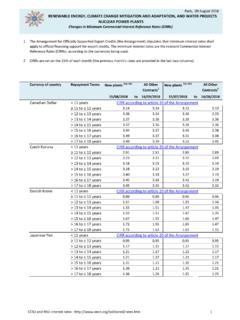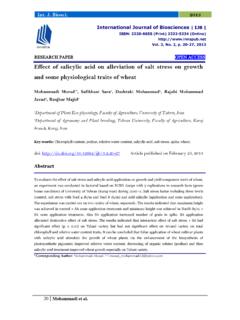Transcription of 2,4-DB 175 - CDMS Home
1 Page 1 of 10. 2,4-DB 175. FOR THE CONTROL OF SEEDLING BROADLEAF WEEDS IN PEANUTS, SOYBEANS, AND SEEDLING STANDS OF ALFALFA, AND FOR USE ON ESTABLISHED STANDS OF ALFALFA. ACTIVE INGREDIENT: Dimethlyamine Salt of 4-(2,4-dichlorophenoxy) butyric acid* .. OTHER INGREDIENTS: .. TOTAL: .. *Equivalent to by weight or lbs. per gallon of 4-(2,4-dichlorophenoxy) butyric acid KEEP OUT OF REACH OF CHILDREN. DANGER PELIGRO. Si usted no entiende la etiqueta, busque a alguien para que se la explique a usted en detalle. (If you do not understand the label, find someone to explain it to you in detail.). SEE INSIDE BOOKLET FOR FIRST AID AND ADDITIONAL PRECAUTIONARY.
2 STATEMENTS. For spill, leak, fire, exposure or accident call CHEMTREC 1-800-424-9300. For Medical Emergencies Only, Call 877-424-7452. EPA REG. NO. 2749-126-1381 EPA EST. NO. 42750-MO-001. NET CONTENTS: GALS. Manufactured For: Winfield Solutions, LLC. Box 64589. St. Paul, MN 55164-0589. 1/1027/5. Page 2 of 10. PRECAUTIONARY STATEMENT. HAZARDS TO HUMANS AND DOMESTIC ANIMALS. DANGER - PELIGRO. Corrosive. Causes irreversible eye damage. May be fatal if swallowed. Harmful if absorbed through skin. Do not get in eyes or on clothing. Avoid contact with skin. FIRST AID. IF IN EYES Hold eye open and rinse slowly and gently with water for 15 to 20 minutes.
3 Remove contact lenses, if present, after the first 5 minutes, then continue rinsing eye. Call a poison control center or doctor for treatment advice. IF Call a poison control center or doctor immediately for treatment advice. SWALLOWED Have person sip a glass of water if able to swallow. Do not induce vomiting unless told to do so by the poison control center or doctor. Do not give anything by mouth to an unconscious person. IF ON SKIN Take off contaminated clothing. OR CLOTHING Rinse skin immediately with plenty of water for 15 to 20 minutes. Call a poison control center or doctor for treatment advice. HOT LINE NUMBER. Have the product container or label with you when calling a poison control center or doctor, or going for treatment.
4 You may also contact CHEMTREC 1-800-424-9300, -877-424-7452 for emergency medical treatment information. NOTE TO PHYSICIANS. For eye irritation, examination by an ophthalmologist may be indicated. If swallowed, probable mucosal damage may contradict the use of gastric lavage. Product contains a phenoxy herbicide chemical. There is no specific antidote. PERSONAL PROTECTIVE EQUIPMENT (PPE): Some materials that are chemical-resistant to this product are made of any waterproof material. If you want more options, follow the instructions for category A on the EPA chemical-resistance category selection chart. All mixers, loaders, applicators and other handlers must wear: long-sleeved shirt and long pants shoes and socks chemical-resistant gloves (except for pilots).
5 Chemical-resistant apron when mixing, loading, cleaning up spills, cleaning equipment, or otherwise exposed to concentrate, and Goggles or face shield See Engineering Controls for additional requirements. Follow manufacturer's instructions for cleaning/maintaining PPE. If no such instructions for washables exist, use detergent and hot water. Keep and wash PPE separately from other laundry. Engineering Control Statement: Pilots must use an enclosed cockpit that meets the requirements listed in the WPS for Agricultural Pesticides [40 CFR (d)(6)]. Pilots must wear the PPE required on this labeling for applicators. Page 3 of 10. USER SAFETY RECOMMENDATIONS.
6 Users should: Wash hands before eating, drinking, chewing gum, using tobacco, or using the toilet. Remove clothing/PPE immediately if pesticide gets inside. Then wash thoroughly and put on clean clothing. Remove PPE immediately after handling this product. Wash the outside of gloves before removing. As soon as possible, wash thoroughly and change into clean clothing. ENVIRONMENTAL HAZARDS. This chemical is toxic to fish. Do not apply directly to water, to areas where surface water is present or to intertidal areas below the mean high water mark. Drift and runoff from treated areas may be hazardous to aquatic organisms in neighboring areas. Do not contaminate water when disposing of equipment washwaters.
7 Do not contaminate water intended for irrigation or domestic purposes. Do not apply when weather conditions favor drift from target area. Groundwater Contamination: Most cases of groundwater contamination involving phenoxy herbicides such as 2,4-DB have been associated with mixing/loading and disposal sites. Caution should be exercised when handling 2,4-DB pesticides at such sites to prevent contamination of groundwater supplies. Use of closed systems for mixing or transferring this pesticide will reduce the probability of spills. Placement of the mixing/loading equipment on an impervious pad to contain spill will help prevent groundwater contamination.
8 This chemical has properties and characteristics associated with chemicals detected in groundwater. The use of this chemical in areas where soils are permeable, particularly where the water table is shallow, may result in groundwater contamination. Application around a cistern or well may result in groundwater contamination. DIRECTIONS FOR USE. It is a violation of federal law to use this product in any manner inconsistent with its labeling. Do not apply this product in a way that will contact workers or other persons, either directly or through drift. Only protected handlers may be in the area during application. For any requirements specific to your State or Tribe, consult the agency responsible for pesticide regulations.
9 AGRICULTURAL USE REQUIREMENTS. Use this product only in accordance with its labeling and with the Worker Protection Standard, 40 CFR part 170. This Standard contains requirements for the protection of agricultural workers on farms, forests, nurseries, and greenhouses, and handlers of agricultural pesticides. It contains requirements for training, decontamination, notification, and emergency assistance. It also contains specific instructions and exceptions pertaining to the statements on this label about personal protective equipment (PPE) and restricted-entry interval. The requirements in this box only apply to uses of this product that are covered by the Worker Protection Standard.
10 Do not enter or allow worker entry into treated areas during the restricted entry interval (REI) of 48. hours. PPE required for early entry to treated areas that is permitted under the Worker Protection Standard and that involves contact with anything that has been treated, such as plants, soil or water, is: coveralls, shoes plus socks, chemical-resistant gloves made of any waterproof material and protective eyewear. Page 4 of 10. PRODUCT INFORMATION. Apply this product only as specified on this label. NOTE: Avoid spray drift to susceptible plants and crops: cotton, tobacco, tomatoes, ornamentals, etc. Coarse sprays are less likely to drift.
